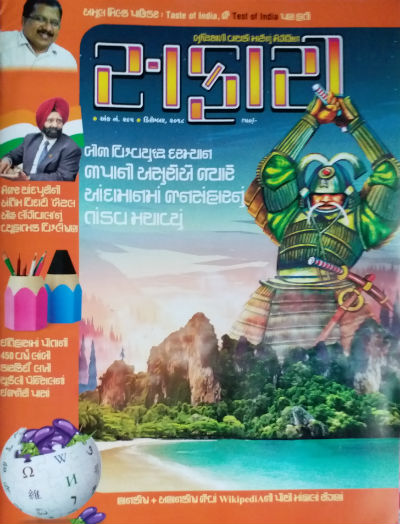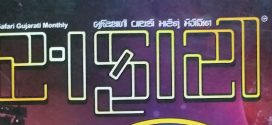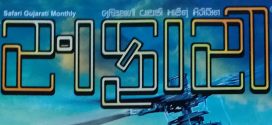We often talk about the dying habit of reading and at the same time we see the market is flooding with tons of reading material including but not limited to books, magazines, and some other stuff. But, more often than not, most of them don’t serve a purpose apart from entertaining one for a limited time. And, of course, there is nothing wrong in that. In fact, in the majority of directory sites, books and magazine reviews are classified into the entertainment category.
However, if we look at the evolution of species, we find that we, human beings became superior to the others due to our ability to think logically and implement it. And, thus, the knowledge is the greatest and most important treasure we have.
Considering that, there are only a few magazines which fall in knowledge spreading category. Safari is a Gujarati magazine from India which serves the purpose since years. It is a monthly magazine and today we are going to talk about its 295th issue. The magazine has a long “off time” in between also. It is sad that such magazines don’t have the readership they deserve. In fact, the English edition of the same is not survived!
Anyway, let us talk about December 2018 issue of the same today.
Let us take a look at the cover page of the issue.

Safari Magazine | Gujarati Edition | December 2018 Issue | Cover Page
The cover page of this issue is quite different and interesting. A Japanese warrior in full war gear striking his sword is a fantastic illustration. It shows the beauty of the islands along with, to represent the theme of the central article. It also feels good to see the photograph of Major Kuldeep Singh Chandpuri (who later became a Brigadier in Indian Army), the hero of the battle of Longewala who left the world behind. There are a few more thumbnails which represent different articles from the issue.
Usually, I start a magazine review by sharing my thoughts about the editorial, but let us make an exception this time. Remembering Brigadier Chandpuri who left this world at the age of 77 on 17th November 2018; is an emotional moment. His bravery was recognised with “Maha Vir Chakra” and he will be remembered for a long. Here is an interview with him where he talks about the battle of Longewala and how much of whatever is shown in the movie Border was true to the reality; from the public domain of YouTube.
Here is one more rare interview with him:
Here is the official promo of Border – a movie based on the battle of Longewala.
Here are some more memories to cherish.
Of course, the movie had taken its own liberties. It is good to read a factual account of the battle of Longewala in this issue of Safari. It is definitely a unique and most needed tribute. Frankly speaking, I’ve expected more details in the article. But, it is definitely a good read.
I highly recommend this issue. If only this article is there in the issue then also it is worth your money and more importantly the time you spend to read it.
It talks about the rate at which tigers were brutally killed by hunters. A thought-provoking read which will make you believe that humans are the deadliest beast when armed with weapons and other resources. Rather than talking more about it, I will suggest you to read it.
Do you know that AMUL is not only the “taste of India” (as it is their slogan) but they have also passed a “Test of India”! Well, for a long, it was accepted around the world that Milk Powder can be created from just Cow Milk. And, it is impossible to make it from a buffalo’s milk! Strange, but true. And there are reasons for the same.
But a man named H. M. Dalaya took the challenge and found an “out of the box” solution for this problem and made a mark.
This is something you must know about. A small yet interesting article.
Pearl Harbor is a nice movie. When the people talk about the atom-bombs America dropped over Japan, they got emotional. And, they rightly condemn this act. Which is right of course. But, do you know that during the world war, the Japanese army also left no stone unturned in overtaking the brutality of the British!
History is always a two-edged blade, if you want to take a look at it neutrally.
There is a detailed article about the massacre (if we can use this phrase) in Andaman. Rather than talking much about it, I will recommend you to read the same. It also refers Netaji Subhash Chandra Bose in the detailed article. And yes, the illustrations, maps and historical images makes the article rich with the information and will make you aware of the unknown or lesser-known facts.
Attaching a video from the public domain for the quick reference:
We all unanimously believe that Wikipedia is considered as one of the most reliable sources of information on almost any topic. The concept of this online encyclopedia which is meant to provide the knowledge to everyone for free is unique and interesting.
We human beings have a tendency to find two sides of any coin :).
If a knife can help in cutting an apple for a patient, it can also be used to harm one as well.
Same is happening everywhere, and WikiPedia is not an exception. In fact, it is us, the people who create, update, pollute, destroy such a good source of information.
Yes, there are some wrong information is available on Wikipedia. And, some of the people edit the stuff there with their own intentions. Some of such articles even fall in “quality articles” at Wikipedia. Often referred to as “WikiPedia Hoaxes”, such articles are meant to provide wrong information and a majority of readers, based on the reputation of Wikipedia, tends to believe it.
Bicholim conflict is one such example. The article talks at a length about a war in India which actually was never fought!
Here are some quick links to know about it:
There is a detailed informative article talking about the reliability of Wikipedia in this issue of Safari Magazine. And, I will highly recommend all the readers to go for it. Wikipedia or any other source of information should be used with a caution and some logical and rational questions must have been asked. And, to confirm the reliability of any information, one should check it with more than one sources of information.
Pencil, a thing we use in our day to day life so obviously that we don’t consider to think about history or science behind the same. Do you know that almost 450 years has been passed since it is invented?
There is an interesting science behind the making of (and using) pencils. Mr. D. N. Kaushik comes up with an interesting article which talks from how it was invented, how and why it is named as “Pencil” and many other aspects. Definitely, an article infused with facts in an interesting manner. Recommended read.
The last cover page of the magazine brings in a detailed, in-depth article about “Neutrinos” as an attempt to answer a question by some readers. Those who are interested in Science, especially astrophysics, will find the article interesting. If this is not your area of interest, then also, the article will bring in some nice information. It is written in such a nice manner that you will not find it too technical but informative.
In addition, there are some regular sections like FactFinder, Q/A, MindGames and others which makes it even more worthy read.
Summary:
Definitely, worth your money and especially the time you spend to read it. Don’t give it a miss. The only thing I can mention as a drawback of this issue is, it is available in a regional language (Gujarati) and thus its reach is limited. This is definitely one of the best resources you can have to enjoy Diwali and welcome the New Year 🙂
Do let us know your views about this article via comments below, we like to read you. And yes, do not forget to share this article with your friends who you think are interested in quality reading. Also subscribe to our newsletter, to get notified periodically about the articles we publish.
 ThinkerViews – Views And Reviews Personal views and reviews for books, magazines, tv serials, movies, websites, technical stuff and more.
ThinkerViews – Views And Reviews Personal views and reviews for books, magazines, tv serials, movies, websites, technical stuff and more.



